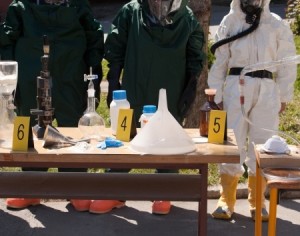Meth is Coming to YOUR House

Congratulations, Walter White. Methamphetamine production (meth, speed, crank crystal meth, “ice” and others) has gone international … big time. There has been a seizure of 2.8 tons of drugs, worth more than $1.5 billion dollars in Australia. There were 1,917 kilograms of MDMA and 849 kilograms of methamphetamine. This made it the largest seizure of meth in Australia and the second largest seizure of MDMA. The previous record for meth seizures was 580 kilograms.
To put this in context, the entire amount of all drugs seized last year by Customs and Border Protection in Australia, was about 5 tons. The Commissioner of the Australian Federal Police, Andrew Colvin, said: “By any measure this is an enormous seizure of illicit narcotics that have been removed from distribution on our streets.” The investigation is ongoing and they expect to arrest more than the initial six Australians currently in custody. “This obviously has linkages overseas that will take us, I’m sure, into Europe and parts of Asia.” They expect to have a number of people and a number of organized crime groups involved.
The drugs were concealed with furniture and other belongings within a sea cargo container that came from Hamburg Germany. The Australian authorities are working closely with the German federal police and Interpol. The message the authorities wanted to send to the “Breaking Bad” individuals involved in this operation was: “Go somewhere else, go to another country. Don’t bring your evil poison here to Australia.”
The UNODC (the United Nations Office on Drugs and Crime) Global SMART Update, Vol. 12, said that in North America, meth production has been primarily within the U.S. and Mexico. The movement in the U.S. to control the precursors for cooking meth, such as pseudoephedrine and ephedrine, led the Mexican drug cartels to begin manufacturing it in large quantities. In February of 2012 Mexican soldiers overran an abandoned ranch south of Guadalajara and found 15 tons of methamphetamine. There was, of course, a laboratory and another seven tons of the precursor chemicals used to manufacture meth. “The cheap and potent meth they supply now provides some three quarters of the drug consumed in America.”
East and South East Asia has been another center for the manufacture and distribution of meth. In 2011 and 2012, eleven countries in the region reported methamphetamine laboratories, “with China (46 percent) and New Zealand (39 percent) accounting for the largest share.” Although Myanmar has reported finding only small-scale meth labs, it is one of the main destinations for trafficked preparations containing ephedrine and pseudoephedrine. This suggests that industrial-scale meth production is going on within that country.
In Africa, the illicit manufacture of meth had been confined to South Africa. But since 2010, laboratories have been reported in Egypt, Nigeria and Kenya. In 2011 and 2012, five large-scale labs were discovered and dismantled in Nigeria. In May of 2012, Nigerian drug enforcement agents raided a building on the outskirts of Lagos and discovered a factory capable of producing 25 kg of crystal meth every few hours. Four large-scale labs have been found in Nigeria. In 2013, Kenya reported that it had dismantled its first meth lab.
In 2008, meth or sheesheh/shishe (Farsi for “glass”) was introduced to Iran. By 2010, Iranian meth manufacturing operations expanded their reach into Japan, Malaysia and Thailand. In 2011 and 2012 Iran reported seizing bulk amounts of ephedrine. By 2012, Iran was the world’s fourth largest importer of pseudoephedrine (used to manufacture meth). Iran spends around 1 billion dollars per year on anti-drug operations. Since 1979, almost 4,000 Iranian law officers have been killed in the country’s fight against the drug trade. In part, this results from severe punishments given out. “Nearly 80% of prosecuted traffickers are given the death penalty.”
One of the primary reasons the use of meth has spread so quickly in Iran is the lack of information. Azarzksh Mokri, a psychiatrist who teaches at Tehran University of Medical Sciences, said: “We really had a hard time convincing people that this is addiction.” Drug use and addiction in Iran is now the second highest cause of death after traffic accidents.
The Global SMART Update Vol. 12 said that illicit methamphetamine manufacture in Europe seems to be concentrated in Central Europe (the Czech Republic, Germany and Slovakia) and the Baltic States, mostly in Lithuania. The Czech Republic typically has small-to medium scale operations that sell their product locally, as well as in Austria and Germany. Conversely, Lithuania has medium-to large-scale laboratories that supply the demand for meth in the Nordic countries and the United Kingdom.
There is a series of twenty segments, or brief reports on global meth operations in the 2014 Global Smart Report. Here is a sampling of three of them. London Police have found a suspected meth lab in a residential area of West London in February. Again in February, a joint operation by U.S. agencies and the Australian Federal Police prevented 60kg of “black ice” methamphetamine from being shipped to Australia. In May, Guatemalan authorities dismantled a lab estimated to manufacture nearly 3 tons of drugs per month.
“Imagine this:
Ice is coming to YOUR house.
Can you HEAR it knocking?
Are you ready?
What will YOU do?”
― Cornelia Connie D. DeDona


